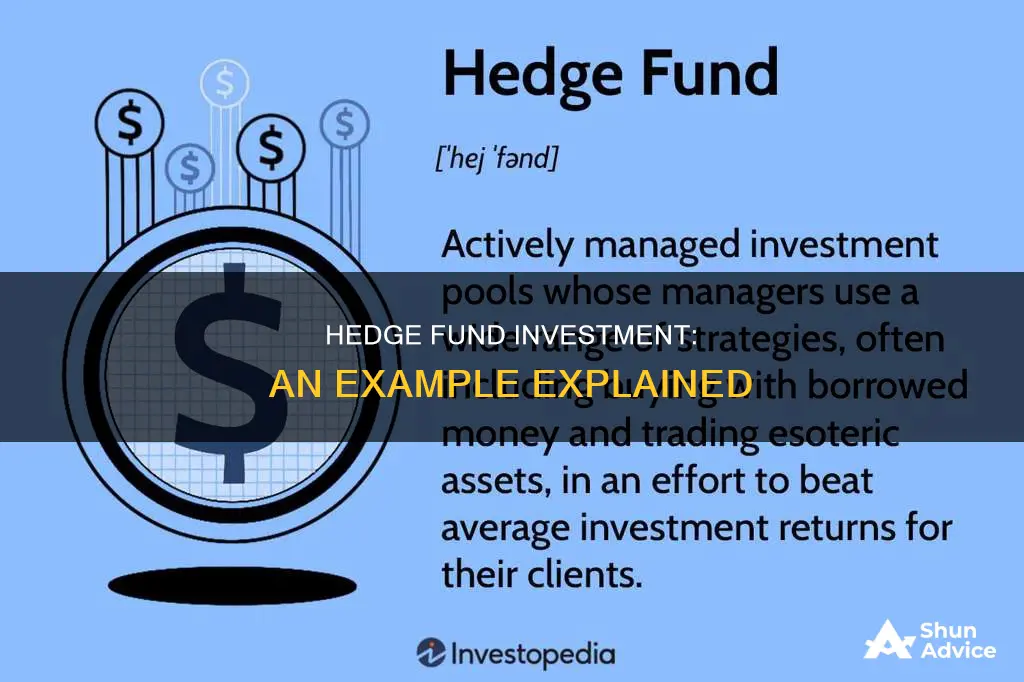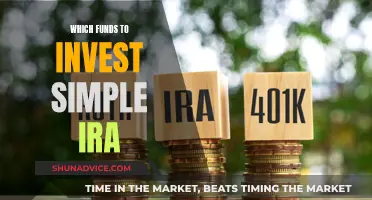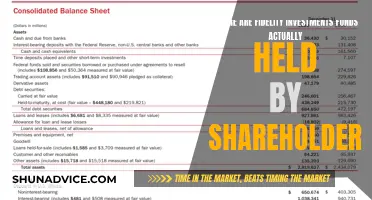
Hedge funds are high-risk, high-reward investments that pool money from wealthy investors to generate as much profit as possible. They are often regarded as risky, alternative investment choices that require high minimum investments. An example of a hedge fund investment is short-selling, where stocks are sold because of a prediction that they will decrease in value. The investor borrows stocks from stockbrokers for a fee, and if the stock does drop in value, they can buy back the shares at a lower cost and turn a profit. However, if the price goes up, the investor will have to return the stocks to the broker at a higher cost than they paid initially, potentially resulting in a significant loss.
| Characteristics | Values |
|---|---|
| Purpose | To maximise returns and reduce or eliminate risk |
| Type of Fund | Private investment partnership |
| Structure | Limited partnership or limited liability company |
| Management | Actively managed by hedge fund managers |
| Investment Type | High-risk, high-reward |
| Investors | Accredited investors and institutional investors |
| Investor Requirements | Net worth of over $1 million or an annual income of over $200,000 |
| Investment Areas | Land, stocks, derivatives, currencies, commodities, non-traditional assets |
| Leverage | Use of borrowed money to multiply returns |
| Fees | Management fee (1-4% per annum) and performance fee (10-50% of profits) |
| Lock-in Period | Minimum of one year |
| Withdrawals | Quarterly or semi-annually |
| Strategies | Global macro, directional, event-driven, relative value arbitrage, long/short, capital structure |
What You'll Learn

Global Macro Strategies
Global macro funds are often actively managed and can be classified into three main categories: currency, interest rate, and stock or equity index strategies. Currency strategies assess the relative strength of currencies, taking into account monetary policies and short-term interest rates. Interest rate strategies focus on sovereign debt interest rates and the economic and political situation of a country. Stock index strategies involve the performance of equity indices and the use of commodities indices.
An example of a global macro strategy in practice can be seen in the Brexit vote in 2016. Global macro hedge funds that anticipated the United Kingdom's decision to leave the European Union took long positions in safe assets like gold and short positions against European stocks and the British pound.
Recovering from Security Fraud: Getting Your Money Back
You may want to see also

Directional Hedge Fund Strategies
US and International Long/Short Equity Hedge Funds
These funds take long positions in stocks expected to increase in value and hedge their bets by short-selling stocks or stock index options. The net market exposure is typically not zero, and the unhedged portion of the portfolio can introduce an element of market timing to the overall return.
Emerging Market Funds
These funds focus on investing in emerging markets such as China and India, where they can take advantage of high growth potential and economic development.
Sector Funds
Sector funds specialize in specific sectors or industries, such as technology, healthcare, biotechnology, pharmaceuticals, energy, or basic materials. They aim to have a deep understanding of the industry and make investments within that sector.
Fundamental Growth and Value Strategies
Funds employing fundamental growth strategies invest in companies with higher earnings growth compared to the overall market or their specific sector. On the other hand, funds using fundamental value strategies seek out and invest in undervalued companies.
Quantitative Directional Strategies
These funds use quantitative and financial signal processing techniques for equity trading. They rely on mathematical models and machine learning techniques to make investment decisions.
Short Bias Strategies
Short bias funds take advantage of declining stock prices by using short-selling techniques. They profit when the price of the underlying stock decreases.
Mutual Funds: Diversify Your Investments, Secure Your Future
You may want to see also

Event-Driven Hedge Fund Strategies
Event-driven strategies are equity-oriented and involve taking long or short positions in the securities of corporations undergoing significant changes. The success of these strategies depends on the fund manager's ability to correctly analyse the impact of the anticipated corporate event and predict the course of restructuring. The strategies can be further classified into relative value or directional positions, depending on the nature of the corporate event.
The performance of event-driven strategies is influenced by the level of corporate activity and the economic cycle. For example, merger arbitrage and event-driven investing tend to flourish during a growing economy, while investing in distressed securities is favoured during a recession.
Event-driven strategies require expertise in analysing corporate events and determining their impact on stock prices. Investors employing these strategies often have teams of specialists who examine corporate actions from multiple perspectives before recommending action.
Overall, event-driven hedge fund strategies offer the potential for substantial profits but also carry significant risks. The performance of these strategies is closely linked to corporate activity and the ability to accurately predict and analyse corporate events.
Floating Rate Funds: A Smart Investment Strategy
You may want to see also

Relative Value Arbitrage Strategies
Here's a step-by-step breakdown of how relative value arbitrage works:
- Identifying Correlated Securities: Relative value arbitrage targets securities that have a historical price relationship and are currently trading out of equilibrium. For example, stocks in the same industry with similar trading histories, such as GM and Ford in the automotive industry or Pfizer and Wyeth in pharmaceuticals.
- Long/Short Trading: When a divergence in price occurs between the two securities, the arbitrageur simultaneously buys one security (going long) and sells the other (going short). This isolates valuation distortions while hedging against general market moves.
- Profit from Convergence: The trader then waits for the prices of the securities to converge again. Once the prices revert to their perceived true value, the trade is liquidated, and the arbitrageur profits from the difference in price between the two securities.
- Market Considerations: Relative value arbitrage is typically used in a sideways market, which is a market that is neither rising nor falling but trading within a specific range. This strategy requires knowledge and skill in evaluating both individual securities and market trends.
- Institutional Investors: Due to the complexity and risks involved, relative value arbitrage is primarily used by large institutional investors such as hedge funds, private equity firms, and investment banks.
Some common relative value arbitrage strategies include:
- Equity Market Neutral: This approach involves identifying overvalued and undervalued stocks within the same sector or industry and taking long and short positions accordingly.
- Fixed Income Arbitrage: This strategy targets relative mispricings between related interest-rate securities, such as treasuries, swaps, futures, and options with varying maturities.
- Convertible Bond Arbitrage: This approach targets pricing discrepancies between a company's convertible bonds and its stock, buying undervalued convertibles and shorting overvalued equities.
- Volatility Arbitrage: This strategy aims to capitalize on distortions in implied and realized volatility across derivatives, such as options and variance swaps.
In summary, relative value arbitrage strategies offer the potential for profits in challenging market environments, such as sideways markets. However, they require significant expertise and are best suited for sophisticated investors who are willing to accept the associated risks.
Mutual Funds: Halal or Haram?
You may want to see also

Long/Short Strategies
Long/short equity is an investment strategy that involves taking long positions in stocks expected to appreciate and short positions in stocks expected to decline. The goal is to minimise market exposure while profiting from stock gains and price declines.
Long-short equity is a liquid alternative strategy commonly used by hedge funds, which often employ a market-neutral strategy where the dollar amounts of both long and short positions are equal. This strategy seeks to take advantage of profit opportunities from securities identified as both under-valued and over-valued.
Long-short equity strategies can be differentiated by market geography (advanced economies, emerging markets, etc.), sector (energy, technology, etc.), investment philosophy (value or growth), and so on. For example, a global equity growth fund would have a broad mandate, while an emerging markets healthcare fund would have a relatively narrow mandate.
A popular variation of the long-short model is the "pair trade," which involves offsetting a long position on a stock with a short position on another stock in the same sector. For instance, an investor in the technology sector may take a long position in Microsoft and a short position in Intel. If Microsoft's stock rises and Intel's falls, the investor profits.
Long-short strategies are also actively managed, with the flexibility to adjust their risk profiles in response to changing market conditions. Managers can reduce overall portfolio exposure, decrease position sizes, or incorporate portfolio protection in the form of index hedges, futures, or options.
During market downturns, long-short equity strategies have demonstrated their ability to mitigate downside risk. Market-neutral strategies, in particular, have proven adept at managing downside risk while allowing investors to participate in up markets.
However, it's important to consider the risks associated with long-short equity strategies, which include market risk, idiosyncratic risk, short-sale risk, and leverage risk.
Manulife Financial: A Regulated Mutual Fund Company?
You may want to see also
Frequently asked questions
A hedge fund is a pool of money from investors that is used to invest in stocks and other assets. Hedge funds are generally more aggressive, riskier, and exclusive than mutual funds. They are also considered alternative investments.
Some examples of hedge funds include Citadel, Bridgewater Associates, Pershing Square, and Renaissance Technologies.
Hedge funds can provide very high returns to investors. They also offer the ability to generate positive returns despite market conditions. Additionally, hedge funds provide investors with access to skilled investment managers and the ability to customize investment strategies.







